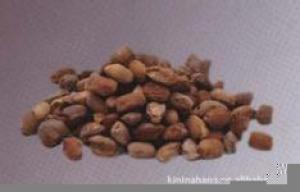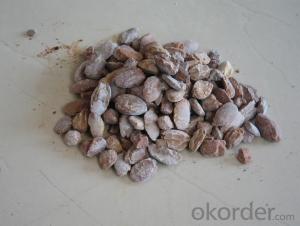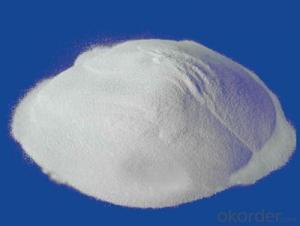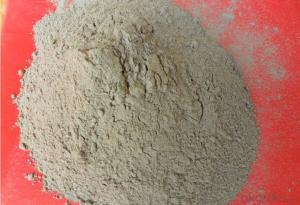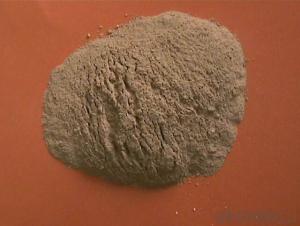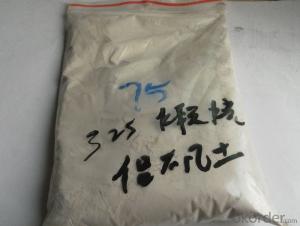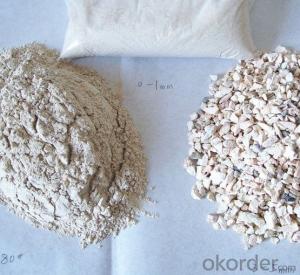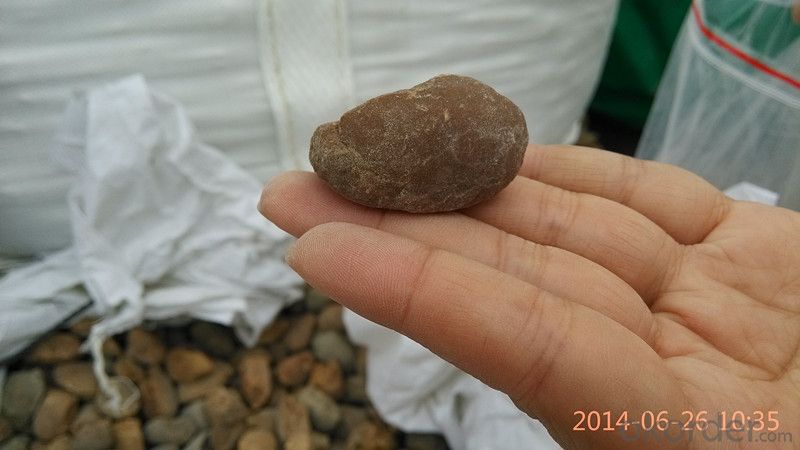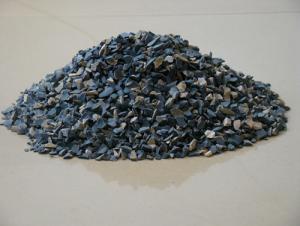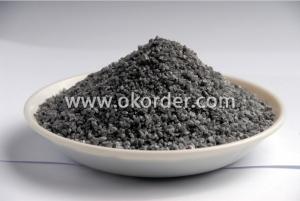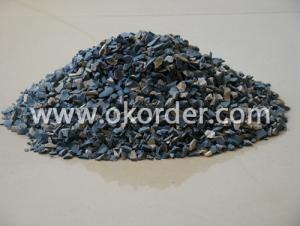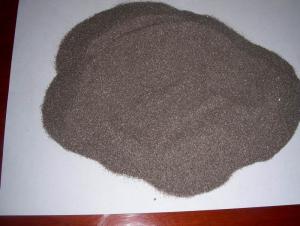Raw Materials for Refractory - Dead Burnt Magnesite MgO 97.2%
- Loading Port:
- Dalian
- Payment Terms:
- TT OR LC
- Min Order Qty:
- -
- Supply Capability:
- 2000 m.t./month
OKorder Service Pledge
OKorder Financial Service
You Might Also Like
| Item | MgO | SiO2 | CaO | LOI | B.D.(g/cm3) |
| DBM-97 | 97 | 0.7 | 1.4 | 0.2 | 3.2 |
| DBM-96 | 96 | 1.5 | 1.5 | 0.2 | 3.2 |
| DBM-95 | 95 | 2.2 | 1.6 | 0.3 | 3.2 |
| DBM-94 | 94 | 3 | 1.6 | 0.3 | 3.2 |
| DBM-93 | 93 | 3.5 | 1.6 | 0.3 | 3.2 |
| DBM-92 | 92 | 4 | 1.6 | 0.3 | 3.18 |
| DBM-92 | 92 | 4 | 1.6 | 0.3 | 3.18 |
| DBM-91 | 91 | 4.5 | 1.6 | 0.3 | 3.18 |
| DBM-90 | 90 | 4.8 | 2 | 0.3 | 3.18 |
| DBM-87 | 87 | 7 | 2.2 | 0.3 | 3.2 |
Dead burned magnesite- DBM-is produced using selected natural magnesite that is purified and is calcined in a shaft kiln.The final product is used for electric furnacefloors and furnace liner tamping.
Main products level :
0-1mm;1-3mm;3-5mm;0-10mm;0-30mm
50 to 325mesh (90% through)
Product feature:
high temperature performance and high-density, strong anti-permeability ability and easy to rapid sintering, very thin sintered layer,good thermal shock stability, strong slag-resistance, long service life and so on.
Product function:
Apply to the construction of bottom and wall of all kinds steel making electric arc furnace and ferroalloy smelting furnace for hot charging of hot metal and second hand steel
Product usage:
Mainly used in producing common magnesite brick, magnesite aluminum brick, magnesite chrome brick, gunning mix, hot patching mix for converter and EAF ect .
Product Advantage:
Our factory produce the products of the Dead-burned magnesite are selected natural magnesite, it is produced by mine-selecting, purifying, calcimine in shaft kiln. It is an ideal material for unshaped refractory material, the final products are used in open hearth furnace, electric furnace bottom and furnace's lining tamping.
- Q: Does the external wall thermal insulation materials level b1 need the fire barrier zone?
- Residential buildings should meet the following requirements: 1, The height of building is greater than or equal to 100m, the combustion performance of thermal insulation material should be level A. 2, The height of building is greater than or equal to 60m but less than 100m, the combustion performance of thermal insulation material should not be less than the level B2. When using the level B2 thermal insulation material, each layer should set a horizontal fire barrier zone. 3,The height of building is be equal or greater than 24m but less than 60m, the combustion performance of thermal insulation material should not be less than the level B2. When using level B2 thermal insulation material, each two-layer should set a horizontal fire barrier zone. 4, The height of building is less than 24m, the combustion performance of thermal insulation material should not be less than the level B2. Besides, when using level B2 thermal insulation material, each three-layer should set a horizontal fire barrier zone. According to this understanding, it can not be set.
- Q: How is the grading of the level A new material fire insulation material?
- The thermal insulation materials are generally divided into level A and level B according to the flame rating. Level A is the non-combustible material, and level B is the combustible materials. The level B material is to blame for the fire in Shenyang hotel in CCTV building a few years ago . At present, the level A materials are widely used, with some prices even cheaper than the level B material. A level is roughly divided into insulation mortar, phenolic board, rock wool board and foam cement board, ect.
- Q: What's the fire endurance of hollow brick?
- This question is really very simple. It is better no to exceed 1050℃, or it will be easily burnt. I think 980℃ is ok actually. This is the maximum limit.
- Q: What is special refractories?
- Long nozzle, slidding plate, tapping hole, stopper rods, and products that steel mills use
- Q: What are included in fireproofing materials?
- There are many types of fireproof materials, and the following listed below is the main species: All kinds of fire retardant coating such as finishing fire retardant paint, fire retardant coating components, fire-resistant coating for steel structure; all kinds of fire-proof materials such as fire?retardant material and its products, textile, fire?retardant fabric, building materials and products, flooring material and external wall thermal insulation system; all kinds of fireproofing components such as fireproof?panel, fire door, fire resistant window frame, fire resisting shutter, fireproofing glass, elevator landing door,ventilating duct, fire-proof?sealing?material and fire protection smoke exhaust fan. The main indicators to judge fire resistance are: Flame retardency, ignition,production of?toxic?gases, smoke density,heat release and exhaust gas; fire resistance, combustion performance, heat of combustion, fire-resistant performance, high temperature resistance, fire?rating, etc. There are some specific parameters which need to be judged by a professional testing equipment. You can go to the inorganic laboratory to check. The test results of fire rating are accurate.
- Q: What are the differences and connections between softening temperature of the refractory under a fixed load and thermal resistant creep property of the refractory?
- The result of refractoriness under load is temperature while the result of creep is percentage of deformation. Refractoriness under load and creep can be tested by an instrument. Refractoriness under load reflects the temperature in which the deformation reaches a certain degree under the condition of load. Creep reflects the deformation refractory has under the condition of constant temperature and load. Both refractoriness under load and creep are important criterion for the operating temperature of refractory.
- Q: Which are roofing fireproofing material?
- (1) Foamed concrete is a kind of fire-proof thermal inuslation matertial featured by good fire resistance and thermal insulation. Besides, it is also characterized by excellent sound proofing, penetration resistance, easy construction, safety and environmental protection without toxin and pollution. (2) Foam glass is featured by light weight, small heat conductivity coefficient and water absorbption, non-inflammability, fire resistance, high strength, no moulding, corrosion resistance, non-toxin and stable physical and chemical properties and thus widely used petroleum, chemical engineering and underground construction. It is also featured by thermal insualtion, heat/cold preservation and sound absorbption and thus can be used for thermal insulation of external wall and roof of civil builduing. Foam glass is featured by stable chemical property, easy to be processed and not easy to deforme, and durable. (3) With slag, basalt and other natural ore as the main raw material, rock wool, mineral wool and its products are made by high temperature melting into fiber, and then processing with binder. It has low thermal conductivity, fire resistance, easy construction and good effects of energy saving and thus is highly cost-effective. (4) With phenolic foam material as main material, phenolic resin plate is made by foaming thermoset phenolic resin. It is featured by light weight, fire resistance, no burning in the air, no smoking, non-toxin, no dropping and non-embrittlement and thus is an ideal thermal insulation material used in HAVC projects. Due to its high obturator formamen rate, low heat conductivity coefficient, good thermal insulation, water resistance and water vapor permeability, phenolic foam is an ideal thermal insulation material.
- Q: What are the materials used in refractory material processing?
- AZS special refractory brick, corundum brick, magnesia chrome brick, silicon carbide, silicon nitride bonded silicon carbide, nitrides, silicides, sulfide, boride, carbide and other non oxide refractory materials; calcium oxide, chromium oxide, alumina, Magnesium Oxide, beryllium and other refractory materials. Often used insulation refractories are diatomite products, asbestos products, insulation panels and so on. Unshaped refractory materials commonly used are fettling, refractory ramming material, refractory castable, refractory plastic material, refractory clay, refractory gunning, refractory cast material, fireproof coating, lightweight castable, mud etc..
- Q: Classification of porosities in refractories and their effects on properties
- Effect of apparent porosity on properties:The porosity is high, the volume density is low, the structure become more loose, generally low strength, corrosion resistance worse (slag infiltration and erosion along the hole toward the inside), but to improve the thermal shock resistance (resistance to thermal shock and not damaged).
- Q: Which fireproofing materials factory is the best in Xiangyang?
- Of course, it is "Lvchuang Construction Energy Saving Engineering Co., Ltd." in Xuzhou, which main products are A-level fireproofing thermal insulation boards. It has many projects. B1-level fireproof materials are polyphenyl boards, extruded sheets, phenolic foam boards, Polyurethane board, sea capacity building energy efficiency module. Flame retardant has been added to the sea capacity building energy efficiency modules which has a B1-level fireproofing performance. You can also add expanded glazed hollow beads to them if you are worried about the security.
Send your message to us
Raw Materials for Refractory - Dead Burnt Magnesite MgO 97.2%
- Loading Port:
- Dalian
- Payment Terms:
- TT OR LC
- Min Order Qty:
- -
- Supply Capability:
- 2000 m.t./month
OKorder Service Pledge
OKorder Financial Service
Similar products
Hot products
Hot Searches
Related keywords
